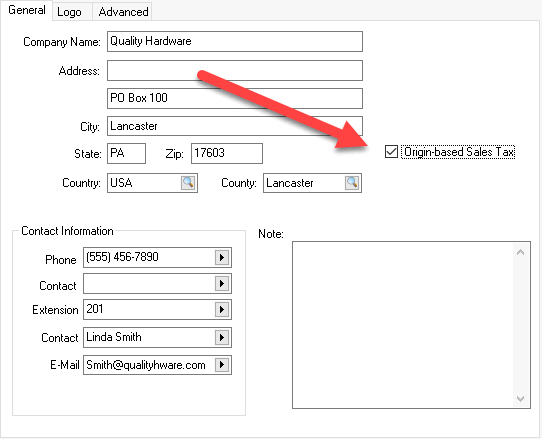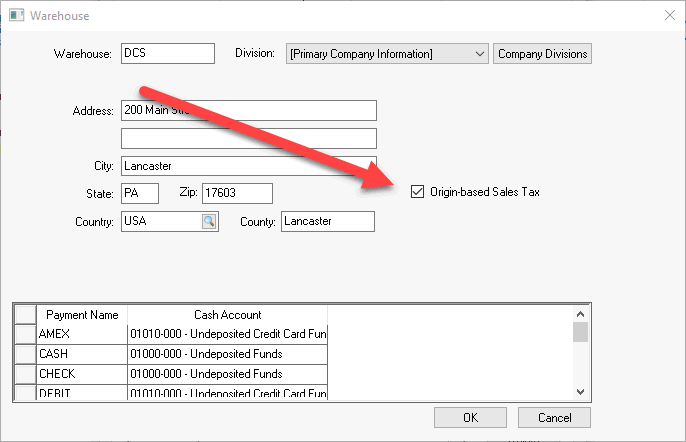Origin vs Destination Sales Tax
Configuring the sales tax calculation to identify
the sales tax “sourcing,” which means the location where a sale is taxed.
Origin-sourced sales are taxed where the seller is located, while destination-sourced
sales are taxed at the location where the buyer takes possession of the
item sold. The more sales that are conducted by a company and the
more customers, potentially the more states may need to be configured
within EBMS to calculate sales tax.
Note that the sourcing option is not based on the
EBMS user]'s discretion but is based on the tax laws of individual states.
As a seller, it is important to know whether you are located
in an origin-sourced state or a destination-sourced state. Many states
and Washington, D.C., are destination-based. Review https://blog.taxjar.com/charging-sales-tax-rates/
for a list of origin based states.
Destination-Based States
Although origin-based sourcing is easier for businesses
to administer because they only have to keep track of the rates where
they are based, most states use destination sourcing, which requires the
company to figure out the correct sales tax rate for any location where
the company is selling and has nexus. Destination-based sales
tax method was the method EBMS used in the past before the Origin-based
option was available in version 8.3.
Origin-Based States
Generally, if you are located in an origin-based state
and make sales to customers within that state, sales tax is based on the
sales location often the main company location. This includes
any local or county taxes that are common in many states. For example,
if you are based in Harrisburg, Pennsylvania, and a sale is made to a
customer in Philadelphia, PA the sales tax rate of 6% (Harrisburg's rate)
is applicable instead of the point-of-possession rate in Philadelphia
of 7%.
If the company is based in Ohio and makes a sale to
another location in Ohio, any city, county or state taxes will be based
on the seller’s location (origin) rather than the customer's location
(destination). Sales taxes are always based on the seller's
location and does not depend if the item is shipped or picked up at the
seller's location.
Remote Interstate Sales
However, origin/destination sourcing rules work differently
if the company is a remote seller, meaning the seller is based in one
state and the customer is located in another state. Contact
an accountant to identify all states where the company has nexus (an obligation
to collect sales tax). Sales are generally destination-based for
sales in a remote state which requires EBMS to be confirmed to calculate
sales tax for the remote state.
If you are selling to customers in a state where you
don’t have nexus, you don’t have an obligation to collect sales taxes.
EBMS must be configured to calculate the appropriate tax rate for
origin-based, destination-based, tax in remote states with nexus, and
no tax for states without nexus. Contact you EBMS software
or consultant or a sales tax accountant to verify that EBMS has been configured
properly.
Configuring Origin-Based Sales Tax
Complete the following steps to configure origin based sales tax. Note
that EBMS defaults to destination based sales tax if a sales location
is not identified as origin based.
Identify if the main sales location is within an origin based
state: Identify origin-based states but reviewing https://blog.taxjar.com/charging-sales-tax-rates/.
Identify if other sales locations of the company are located
in origin-based states:
If the company maintains a single sales location (Single
Profile) and that main location is located in an origin-based
state then complete the following steps:
Open the following dialog by selecting File > Company Information from
the main EBMS menu and clock on the General
tab as shown below:

Enable the Origin-based
Sales Tax option as shown above. Note
that this option will not appear if EBMS is configured to management
multiple sales locations.
If the company has multiple sales locations (Based
on Warehouses) and any of these locations are within an origin-based
state the complete the following steps:
Open the Inventory >
Options > Warehouse tab from the main EBMS menu as shown
below:

Select a Warehouse
that identifies the sales location and click Properties
to open the following dialog:

Enable the Origin-based
Sales Tax option if the warehouse or sales location
is within an origin-based state. Click OK to save.
Repeat for all other warehouse locations.


